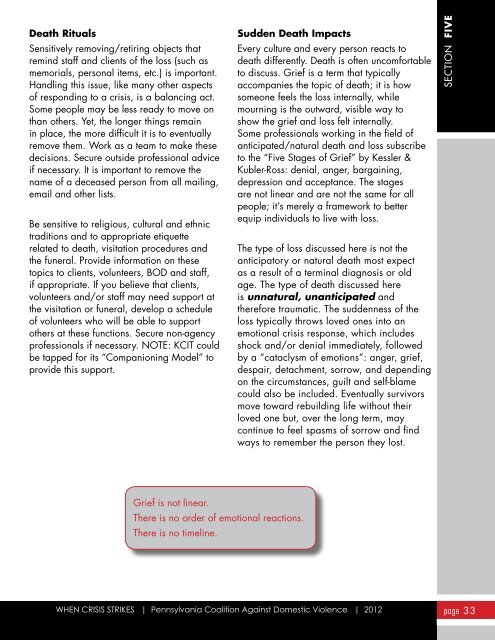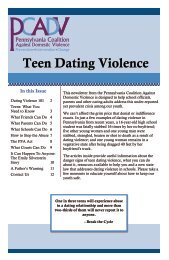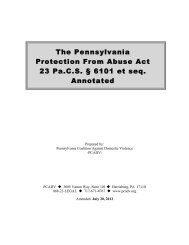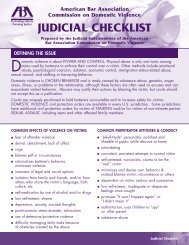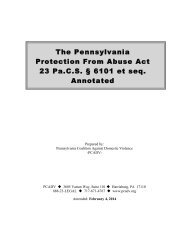Toolkit with Report Form - Pennsylvania Coalition Against Domestic ...
Toolkit with Report Form - Pennsylvania Coalition Against Domestic ...
Toolkit with Report Form - Pennsylvania Coalition Against Domestic ...
You also want an ePaper? Increase the reach of your titles
YUMPU automatically turns print PDFs into web optimized ePapers that Google loves.
Death Rituals<br />
Sensitively removing/retiring objects that<br />
remind staff and clients of the loss (such as<br />
memorials, personal items, etc.) is important.<br />
Handling this issue, like many other aspects<br />
of responding to a crisis, is a balancing act.<br />
Some people may be less ready to move on<br />
than others. Yet, the longer things remain<br />
in place, the more difficult it is to eventually<br />
remove them. Work as a team to make these<br />
decisions. Secure outside professional advice<br />
if necessary. It is important to remove the<br />
name of a deceased person from all mailing,<br />
email and other lists.<br />
Be sensitive to religious, cultural and ethnic<br />
traditions and to appropriate etiquette<br />
related to death, visitation procedures and<br />
the funeral. Provide information on these<br />
topics to clients, volunteers, BOD and staff,<br />
if appropriate. If you believe that clients,<br />
volunteers and/or staff may need support at<br />
the visitation or funeral, develop a schedule<br />
of volunteers who will be able to support<br />
others at these functions. Secure non-agency<br />
professionals if necessary. NOTE: KCIT could<br />
be tapped for its “Companioning Model” to<br />
provide this support.<br />
Sudden Death Impacts<br />
Every culture and every person reacts to<br />
death differently. Death is often uncomfortable<br />
to discuss. Grief is a term that typically<br />
accompanies the topic of death; it is how<br />
someone feels the loss internally, while<br />
mourning is the outward, visible way to<br />
show the grief and loss felt internally.<br />
Some professionals working in the field of<br />
anticipated/natural death and loss subscribe<br />
to the “Five Stages of Grief” by Kessler &<br />
Kubler-Ross: denial, anger, bargaining,<br />
depression and acceptance. The stages<br />
are not linear and are not the same for all<br />
people; it’s merely a framework to better<br />
equip individuals to live <strong>with</strong> loss.<br />
The type of loss discussed here is not the<br />
anticipatory or natural death most expect<br />
as a result of a terminal diagnosis or old<br />
age. The type of death discussed here<br />
is unnatural, unanticipated and<br />
therefore traumatic. The suddenness of the<br />
loss typically throws loved ones into an<br />
emotional crisis response, which includes<br />
shock and/or denial immediately, followed<br />
by a “cataclysm of emotions”: anger, grief,<br />
despair, detachment, sorrow, and depending<br />
on the circumstances, guilt and self-blame<br />
could also be included. Eventually survivors<br />
move toward rebuilding life <strong>with</strong>out their<br />
loved one but, over the long term, may<br />
continue to feel spasms of sorrow and find<br />
ways to remember the person they lost.<br />
Section five<br />
Grief is not linear.<br />
There is no order of emotional reactions.<br />
There is no timeline.<br />
When Crisis Strikes | <strong>Pennsylvania</strong> <strong>Coalition</strong> <strong>Against</strong> <strong>Domestic</strong> Violence | 2012 page 33


